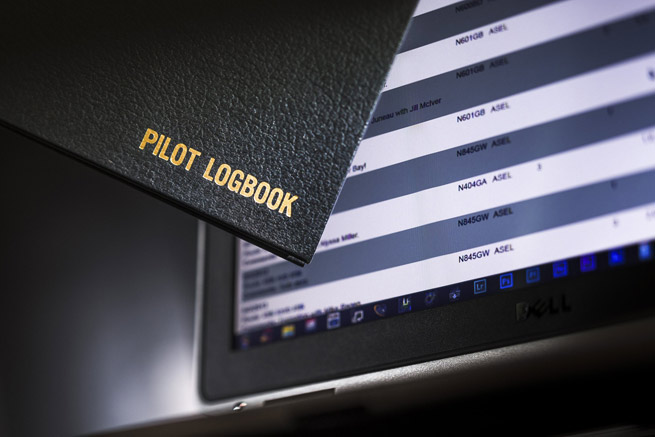
Around the office we often joke that Senior Editor Ian Twombly is the youngest old man here. In this discussion, he may prove that point again. He favors the paper logbook; Senior Editor Dave Hirschman goes virtual.

Tell a better story
Digital logbooks give a fuller picture
By Dave Hirschman
Wax poetic about the soulful and sensual texture of your precious leather-bound pilot logbook if you must, but be honest about its limitations. It’s easy to lose, hard to read, conveys scant information, and likely is incomplete or incorrect because of your own errors and omissions. Digital logbooks solve all these problems—and they can become active catalysts that provide future-looking notifications far beyond the passive role of legacy logbooks.
• First, a digital logbook is stored in the cloud so you can’t lose it, and you can access it from anywhere.
• It’s legible, and you have as much space for entries as you want, so you don’t have to engage in the squinting CFI practice of micro-writing.
• It’s easy to attach photos, videos, maps, and other digital mementos of any flight.
• It does the math for you, so addition errors and Wite-Out are things of the past.
• It keeps a running tally of the things insurance companies and 8710 forms want to know, like time in type, night takeoffs and landings, retract time, et cetera—and reminds you via email notification when you’re close to slipping out of currency.
A digital logbook reduces data entry time and mistakes. Tell it the registration number of the airplane you’re flying and it will know whether to log the time as complex, high performance, tailwheel, retractable, multi, seaplane, and the rest.
My favorite digital logbook is MyFlightBook.com, and it’s free, smart, and thoughtfully created by a fellow pilot. If you want to share your flying experiences via social media, you can do so at the touch of a button. There are even quizzes on various airports and a pat on the back for new ratings and achievements.
I like the ease and accuracy MyFlightBook provides. And filling it out doesn’t seem like a chore.
I’ve always treasured my paper logbooks. But I’ve been a less than faithful correspondent over the years. There are unexplained gaps in entries, usually when I got to the end of one logbook and hadn’t purchased the next one. There are some blocks where I’ve filled in a large number of estimated hours from reconstructed records, fuel receipts, and my own faulty memory.
My own slippery slope comes when I fail to make a few entries in a timely way, realize I’m behind, but am too lazy to face up to it. Finally, I get disgusted and catch up all at once with a flurry of staccato entries that provide only the bare minimums.
An electronic logbook gives a much richer picture of your flying experiences, preserves sights and sounds, and enhances sharing. My favorite feature is that it provides a graphic depiction of all your flights in one multicolored, mind-bending map—and that alone is worth the tedium of going back and keying in your flight data.
I haven’t entirely abandoned my paper logbooks just yet. Old habits die hard.
But the legacy logbook I’m filling out now is almost certainly the last I’ll do in ink. And if I ever miss having a paper logbook, one tap of the Print button will provide a complete, tangible record.
Email [email protected]

Pen, paper, perfection
The classic method is still the best
By Ian J. Twombly
Of all a pilot’s possessions, the logbook is rightfully the most cherished. It’s a journal mixed with statements of fact that transcend the numbers and notes of each entry. That is to say, it has absolutely no business being replaced with a series of 1s and 0s in someone’s basement computer.
To be fair, I hate usernames, web addresses, passwords, and all the other frustrations that are par for the digital course. Getting into my bank account is harder for me than it is for a hacker. So there is no chance I would give up a paper logbook in favor of one that lives solely “in the cloud.” More than that, digital logbooks are an affront to the whole logbook culture.
Flying is still a romantic pursuit. We still think about it the way Leonardo da Vinci did, and write about it the way John Gillespie Magee Jr. did. In that world, the logbook is our box of mementos, something we will hold on to long after the immediate infatuation of the flight has faded.
I remember discovering my grandfather’s logbooks, all lined up neatly in a row on a bookshelf in the basement. Each one was small and the pages delicate. I can only hope that if they so choose, someday my own kids and their kids will have the first-person account of my flying life to pore over and imagine what flying was like way back in 2014. The slip of paper with the password for that electronic logbook will be 50 feet deep in a landfill by then.
But even before my kids have the chance to keep it on their own bookshelves, I enjoy the nostalgia myself. Occasionally I’ll have a need to go back and total up a certain subset of experience or reference some date. And every time I get to experience the flights again. Some people keep meticulous logbooks, but I love the character that comes from having one with different colors of ink and a few dates out of order.
I can only imagine what that experience would be like on a computer. Scroll, skim, scroll, skim, get distracted by email, scroll. That’s not embracing a memory, it’s research.
Advocates of electronic logbooks say they are great for crunching numbers, and I suppose that’s true. I also don’t care. I’m not a professional pilot and I’m long past the point of tracking my total multi time to the tenth.
They also say electronic logbooks are more secure than a paper logbook, which is hogwash. I would put money on my digital life being hacked long before my house burns down, and not because all my passwords just happen to be “password.” Keep your logbook in your car and all bets are off, though.
The biggest problem with a digital logbook is that it misses the point. Keeping a physical record of your aerial adventures isn’t required every time we fly, but most of us do it because we want to. The act of putting pen to paper is worth the time and effort, and it says something about how you approach flying—not to mention that your grandkids will thank you.
Email [email protected]


